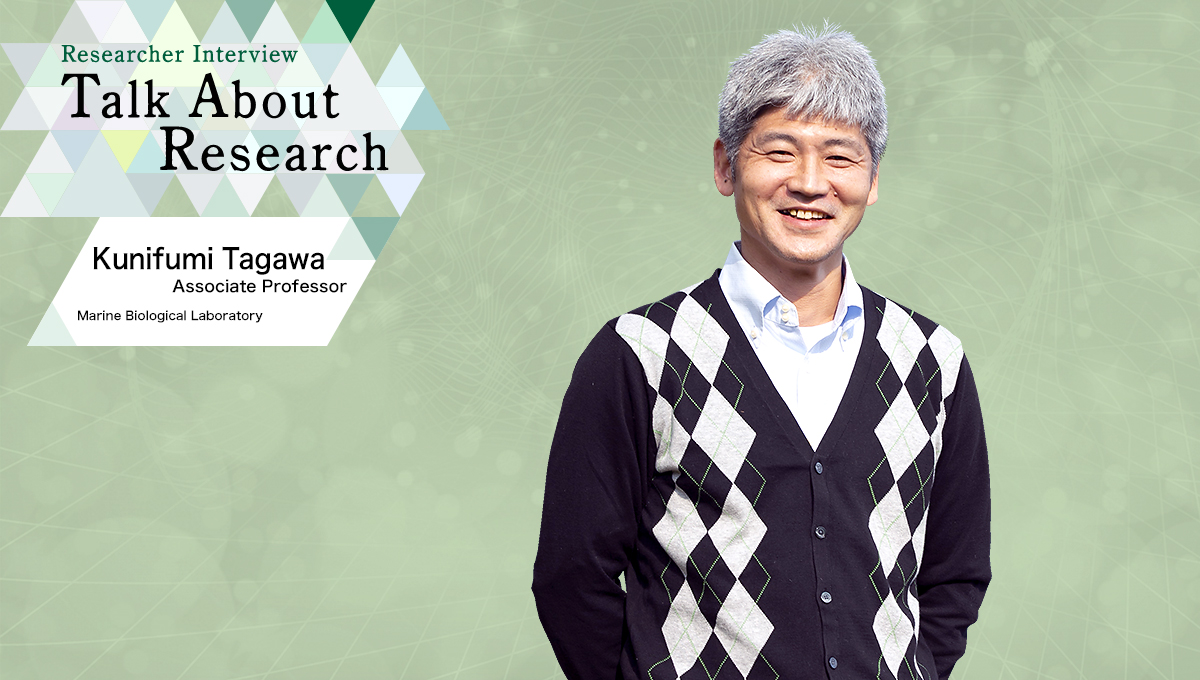Associate Professor Tagawa started
the world’s first molecular developmental biology study of the hemichordates
and succeeded in decoding the genome for the first time in a hemichordate
Associate Professor Tagawa specializes in developmental biology. His research focuses on unfamiliar marine fauna, exploring their phylogenetic evolution. His main research subject is the hemichordates. He started his research on the hemichordates as the first researcher in the world when he was a graduate student and sent to California. He succeeded in isolating and analyzing genes involved in development and clarifying novel gene expression patterns commonly expressed in the mouth and anus of bilaterally symmetrical animals (Bilateria). After accumulating such research achievements, he finally succeeded in decoding the genome in 2015. He aims to clarify the mechanism of animal evolution by analyzing various factors related to the development, evolution, and regeneration of his research subjects in comparison with other animals.
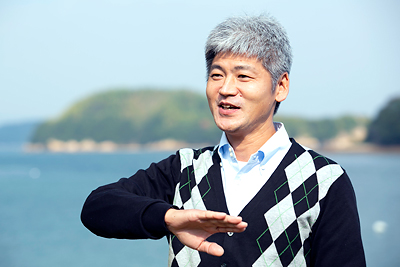
There are currently more than 30 phyla of animals on the earth, and most of them are classified as Bilateria. Among them, the Hemichordata is classified in the same deuterostome group that consists of the phylum Chordata that includes the human, and the phylum Echinodermata that includes sea urchins and sea cucumbers.
“The acorn worm resembles the ragworm and earthworm. Its Japanese name, ‘giboshimushi’ came from the fact that the front end of the animal resembles an ornament called giboshi used on temples and the railings of bridges. The reason why they are called ‘hemichordata’ is because their body structure is very similar to that of chordates,” he says. Noteworthy is an organ called the stomochord.
 Hawaiian acorn worm, Ptychodera flava
Hawaiian acorn worm, Ptychodera flava
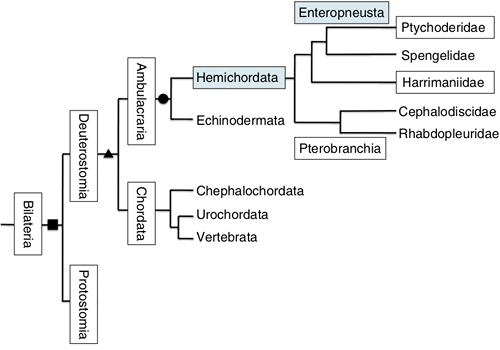 Fig. 1: Classification scheme of the hemichordates
Fig. 1: Classification scheme of the hemichordates (Source: Curr. Opin. Gent. Dev. 39, 71-78, 2016)
It is thought that having two openings in the body, the mouth and anus, with a unidirectional gut between them, i.e., eating food through the mouth and excreting it through the anus, is an important feature acquired during the evolution of Bilateria. (In contrast, cnidarians, such as jellyfish, that emerged before Bilateria have a single opening in the body, which functions as both the mouth and anus.) It has been suggested that the stomochord had an evolutionary relationship with organs derived from the anterior pharynx of chordates. Through the aforementioned genome deciphering, his research group has revealed that the origin of gills, which have been regarded as a characteristic of chordates, was already acquired in the common ancestor of the deuterostomia.
 Fig. 2: Characteristic body structure of the enteropneust hemichordates
Fig. 2: Characteristic body structure of the enteropneust hemichordates (Source: Development 126, 85-95, 1999)
“We think the hemichordates could be an important missing link in evolution. I would like to continue to clarify the process of evolution that leads to chordates through the study of the hemichordates,” he says enthusiastically.
The hemichordates is also notable for their ability to regenerate. “When we cut the body of a hemichordate in half, it regenerates the parts it lost and comes back to the original form. In contrast, we humans have limited regenerative capacity. I would like to continue to keep exploring the regeneration mechanism to find out what is the cause of this capability,” he says. His research focuses on the analyses of genes that are specifically expressed in regeneration buds and genes involved in cell reprogramming. He received the Zoological Science Award and Fujii Award in 2011. His studies have been recognized as meaningful research material for the study of regeneration and development of hemichordates.
Released the genome sequence of Praesagittifera naikaiensis of phylum Xenacoelomorpha. This can also be used as a model organism
Dr. Tagawa is currently a member and director of Marine Biological Laboratory, Graduate School of Integrated Sciences for Life, Hiroshima University. This laboratory has a long history, having been established in 1933 as the seaside laboratory of Hiroshima University of Literature and Science, in the current location of Mukaishima Town, Onomichi City. In the sea near the laboratory, Dr. Tagawa collected another research subject, Praesagittifera naikaiensis, and is working to solve the mysteries of development and evolution from a different angle.

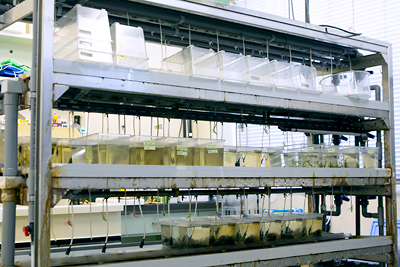
“The acoelomorpha is included in the phylum Xenacoelomorpha and is thought to be at the base of bilateral animals. Around the laboratory, it is easy to find and collect Praesagittifera naikaiensis, a species of the phylum. So I go out with students for sampling, and we conduct various studies with a view to establishing it as a model organism.”
In his work on Praesagittifera naikaiensis, Dr. Tagawa has initiated the first molecular biological analysis of the species, and in 2019, he decoded and released its genome sequence. He received the Zoological Science Award and Fujii Award in 2020 for his contribution to research in this field.
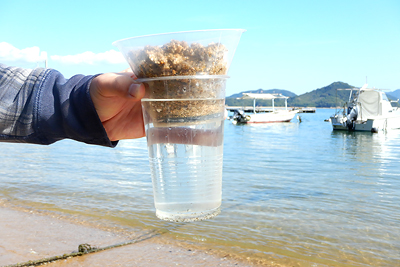 Sampling the acoelomorpha
Sampling the acoelomorpha
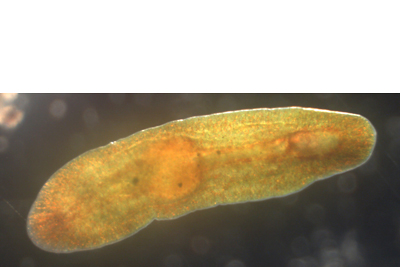 Praesagittifera naikaiensis
Praesagittifera naikaiensis
I want to prove the mechanism of evolution by experimenting with
genome editing technologies to create something new
Dr. Tagawa, who is trying to get closer to the mechanisms of development and evolution, has a future goal of unveiling mysteries of evolution at the phylum level. At the root of his research is an interest into how humans were originated and how they evolved. He also said, “It is interesting to use animals that are not well known to the public, such as the acorn worms and acoel flatworms.”
“I hope that by studying development and regeneration, we will be able to shed some light on the mechanisms of evolution. As information about genomes has accumulated, commonality has become better understood, but there are still many things we do not understand. For example, an animal with the notochord would never emerge from the egg of an animal without the notochord. Why is that? I would like to understand mysteries like this.”
Furthermore, he says, “I would be happy if the hemichordates and acoelmorphs were to be included in high school biology textbooks, for example, and recognized as being as important as ascidians and lancelets, which are considered to have an important place in evolution.”
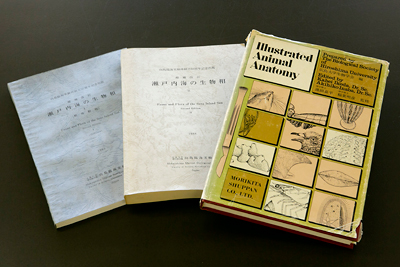 On the right in the photo is an old book on animal anatomy stored in the Marine Biological Laboratory. This book, written by the members of the Biological Society of Hiroshima University, has gone through many editions and is still popular as a biology textbook for university students.
On the right in the photo is an old book on animal anatomy stored in the Marine Biological Laboratory. This book, written by the members of the Biological Society of Hiroshima University, has gone through many editions and is still popular as a biology textbook for university students. The books on the left and at the center are the publications of the Marine Biological Laboratory on the biota of the Seto Inland Sea.
For future research, he would like to take the approach of proving evolution by creating something new, rather than trying to testify the great theories by going backward through the black box. Such an approach is made possible by genome editing technology, which is becoming more and more accessible.
“For example, it might be possible to create an animal that possesses a trait that is thought to have been newly acquired in a certain phylum by editing the genome of an animal that does not possess it. We are yet to figure out a specific way to do that, but I want to make sure we are well prepared and never give up until the end.”
“Above all, I want people to know that marine life is diverse, mysterious, and interesting,” says Dr. Tagawa. He hopes that the hidden potential of developmental biology will also be widely recognized.
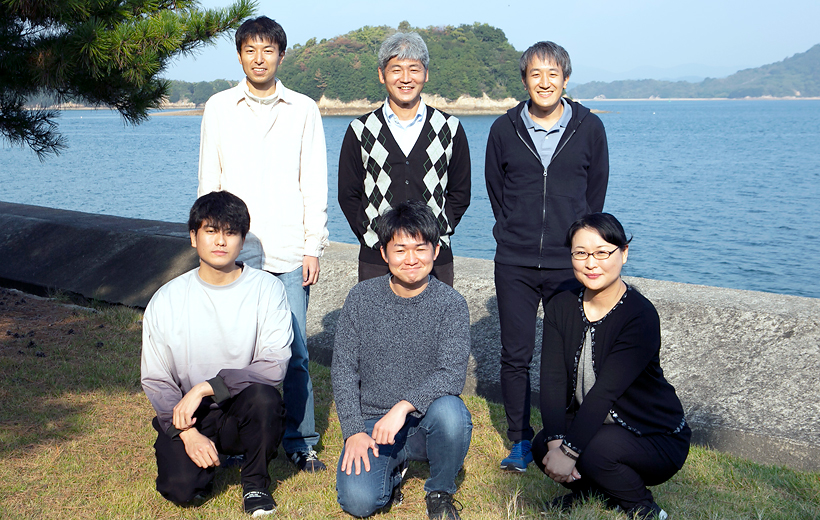 Opened on June 8, 2022
Opened on June 8, 2022

